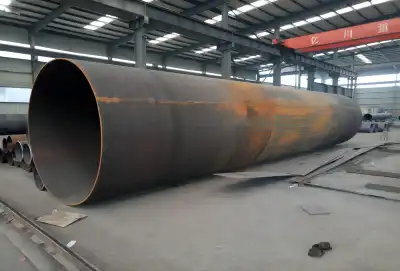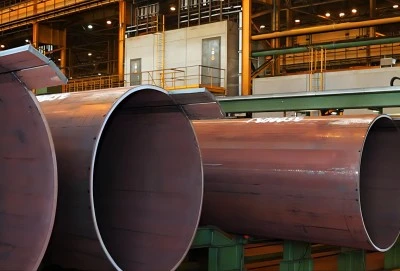Long Seam Welded Pipe is a basic component in different businesses, especially in oil and gas transportation, water supply frameworks, and basic applications. Guaranteeing the welding quality of these channels is pivotal for their execution, security, and life span. This article will investigate the key steps and contemplations in keeping up tall welding quality that meets or surpasses industry measures.
|
|
|
Welding process assessment:
The first step in ensuring high-quality welds in Long Seam Welded Pipes is a thorough assessment of the welding process. This involves evaluating the welding procedure specifications (WPS) and ensuring they align with relevant industry standards such as API 5L or ASTM A252. A comprehensive welding process assessment should include:
1. Verification of welding parameters: This includes checking the welding current, voltage, travel speed, and heat input. These parameters must be optimized for the specific pipe material and thickness to ensure proper fusion and penetration.
2. Evaluation of welding equipment: The welding machines, wire feeders, and other equipment should be regularly calibrated and maintained to ensure consistent performance.
3. Review of welding consumables: The selection of appropriate welding wires and fluxes is crucial. These consumables should be compatible with the base material and capable of producing welds that meet the required mechanical properties.
4. Assessment of welding sequence: The order and method of applying weld passes can significantly impact the final weld quality. A proper welding sequence helps minimize distortion and residual stresses.
5. Qualification of welding operators: Ensure that all welding operators are properly trained and certified according to relevant standards such as AWS D1.1 or ASME Section IX.
By thoroughly assessing and optimizing the welding process, manufacturers can establish a solid foundation for producing high-quality Long Seam Welded pipe. Regular review and updating of the welding process assessment are essential to maintain quality standards and incorporate improvements in welding technology.
Material Control:
The quality of the base material plays a crucial role in the overall welding quality of Long Seam Welded Pipes. Effective material control involves several key aspects:
1. Material selection: Choose steel grades that are appropriate for the intended application and compatible with the welding process. The chemical composition and mechanical properties of the steel should meet the requirements specified in relevant standards.
2. Material traceability: Implement a robust system for tracking materials from receipt through production. This includes maintaining proper documentation of material certificates and heat numbers.
3. Storage and handling: Proper storage and handling of steel plates or coils are essential to prevent contamination, moisture absorption, or physical damage that could affect weld quality.
4. Pre-weld preparation: Ensure that the material is properly cleaned and prepared before welding. This may include edge preparation, removal of mill scale or rust, and preheating if required.
5. Material testing: Conduct regular testing of incoming materials to verify their properties. This may include chemical analysis, mechanical testing, and non-destructive testing.
By implementing stringent material control measures, manufacturers can significantly reduce the risk of weld defects and ensure that the final product meets the required specifications. Material control is an ongoing process that requires constant vigilance and adherence to established procedures.
On-site welding control:
Effective on-site welding control is c:ritical for maintaining consistent weld quality in Long Seam Welded Pipe production. This involves monitoring and controlling various factors during the actual welding process:
1. Environmental conditions: Control the welding environment to minimize the impact of factors such as temperature, humidity, and wind. This may involve using windshields or climate-controlled welding stations.
2. Fit-up and alignment: Ensure proper fit-up and alignment of pipe edges before welding. Poor fit-up can lead to a lack of fusion, incomplete penetration, or other weld defects.
3. Preheat and interpass temperature control: Monitor and maintain proper preheat and interpass temperatures as specified in the WPS. This helps prevent cracking and ensures proper weld metal properties.
4. Welding parameter monitoring: Continuously monitor welding parameters such as current, voltage, and travel speed to ensure they remain within the specified ranges.
5. Visual inspection during welding: Perform ongoing visual inspection during the welding process to identify and correct any issues promptly.
6. Distortion control: Implement measures to control and minimize distortion during welding, such as proper clamping and sequencing of weld passes.
By maintaining strict control over the on-site welding process, manufacturers can ensure consistent weld quality and minimize the occurrence of defects. Regular training and supervision of welding operators are essential components of effective on-site welding control.
Welding inspection and quality feedback:
Comprehensive inspection and quality feedback processes are crucial for ensuring that the welding quality of Long Seam Welded Pipe meets industry standards. These processes involve:
1. Non-destructive testing (NDT): Implement a rigorous NDT program, which may include methods such as radiographic testing, ultrasonic testing, magnetic particle inspection, and penetrant testing. The extent and frequency of NDT should comply with relevant standards and customer requirements.
2. Destructive testing: Conduct periodic destructive tests on weld samples to verify mechanical properties such as tensile strength, impact toughness, and hardness.
3. Visual inspection: Perform thorough visual inspections of completed welds to identify surface defects, irregularities in weld profile, and other visible issues.
4. Dimensional inspection: Check the dimensions of the welded pipes to ensure they meet the specified tolerances for diameter, wall thickness, and straightness.
5. Documentation and record-keeping: Maintain detailed records of all inspection results, including NDT reports, mechanical test results, and any non-conformances identified.
6. Quality feedback loop: Establish a system for analyzing inspection results and feeding this information back into the production process.
7. Corrective action: Implement a robust system for addressing any non-conformances or defects identified during inspection. This ought to incorporate root cause examination and preventive measures to dodge recurrence.
By executing comprehensive review and quality criticism forms, producers can guarantee that their Long Crease Welded Channels reliably meet or surpass industry measures. These forms moreover give important information for the persistent advancement of welding quality
Long seam welded pipe Supplier:
Choosing a reliable supplier for long-seam welded pipes is crucial for ensuring consistent quality and performance. When selecting a supplier, consider factors such as their manufacturing capabilities, quality control processes, adherence to international standards, and track record in the industry.
LONGMA GROUP's products Welding Type: If you are choosing your long-seam welded pipe manufacturers, welcome to contact us at info@longma-group.com.
In conclusion, ensuring that the welding quality of Long Seam Welded Pipe meets industry standards requires a comprehensive approach that encompasses welding process assessment, material control, on-site welding control, and rigorous inspection and quality feedback processes. By implementing and continuously improving these practices, manufacturers can produce high-quality pipes that meet the demanding requirements of various industries.














